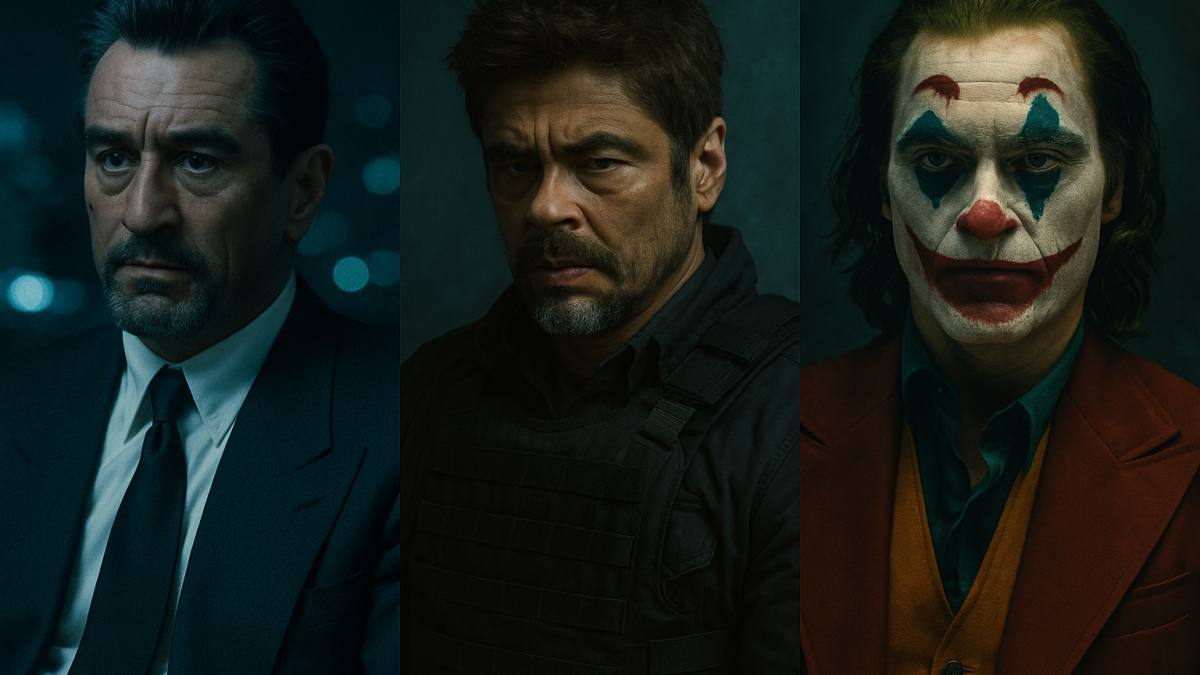The Last Office Hours: The Quiet Collapse of the Intellectual
April 17, 2025
5 Sports Cars You Should Snag Now Before Prices Go Crazy (Thanks, Tariffs!)
April 26, 2025🚬 Introduction: The Last Man Standing Is Lost
Once upon a time, the male hero in cinema was a stoic professional—grizzled, flawed, yes, but principled. He lived by codes, died by them, and somewhere in the audience, we felt reassured that somebody still knew the rules.
Fast-forward thirty years and that hero has been replaced—by a ghost, a sociopath, or a meme. The line between villain and hero has evaporated, and what remains is a cultural Rorschach test in boots. We’ve gone from Neil McCauley to Alejandro Gillick to Arthur Fleck, each more fractured and morally adrift than the last.
In the era of Trump—an era of spectacle, chaos, and performative masculinity—the male cinematic archetype has gone full ouroboros: devouring itself in a loop of power, confusion, and identity crisis. Let’s take a ride through time.
I. 1995: Heat and the Hero with a Code
Michael Mann’s Heat was not just a heist movie—it was an elegy for a certain kind of man. Neil McCauley (Robert De Niro) was a thief, yes, but a craftsman. His mantra? “Don’t let yourself get attached to anything you are not willing to walk out on in 30 seconds flat if you feel the heat around the corner.”
Vincent Hanna (Al Pacino), his police counterpart, was just as obsessive. Together, they formed a yin-yang of masculine discipline. They were mirror images, locked in a doomed ballet of mutual respect.
Archetype: The Stoic Professional – emotionally contained, lethal, and governed by an inner code.
🎞️ These men were shaped by systems—cops, robbers, military, meritocracy—and those systems still had some semblance of order.
II. 2015: Sicario and the Weaponized Ghost
Jump twenty years to Sicario. The desert is hotter. The violence is uglier. The institutions are cracked.
Enter Alejandro Gillick (Benicio del Toro), a man hollowed out by personal loss and state-sanctioned revenge. He operates with terrifying precision, but without moral anchor. He’s a ghost. He exists only to haunt others.
Emily Blunt’s character—idealistic, principled—serves as the audience’s proxy. And like us, she’s powerless. She watches the monster work and is left with nothing but nausea and a pen to sign her surrender.
Archetype: The Wounded Predator – efficient, unfeeling, existing beyond law or morality.
🎞️ Violence is no longer justified by justice. It is its own logic now, devoid of heroism.
III. 2025: Joker, Reacher, and the Fragmented Male
Today’s cinematic male is an algorithm of contradictions. He is self-aware but emotionally stunted. Brutal, yet strangely infantilized. He quotes Nietzsche but collapses in panic attacks.
Take Joker (2019): Arthur Fleck is a failed comic, a mentally ill loner, and a human Molotov cocktail thrown into a collapsing city. There’s no honor here. Just entropy, loneliness, and spectacle.
Or look at Reacher—a cartoonish, hyper-masculine throwback who’s more meme than man. He’s not a hero. He’s a power fantasy built for short-form content.
Archetype: The Fragmented Male – psychologically shattered, performative, and alienated.
🎞️ This man doesn’t save the day. He barely survives it. And sometimes, he causes the very disaster he was meant to prevent.
IV. Trump: The Shadow King
No discussion of contemporary masculinity is complete without invoking the Trump Effect—a vulgar, orange-toned specter that haunts the masculine imagination like a carnival mirror.
Trump doesn’t play a masculine archetype—he is one, but grotesquely amplified: all dominance, no depth; all swagger, no substance. Cruelty is framed as authenticity. Lies as confidence. Weakness masquerading as alpha male bravado.
This cultural shift didn’t just influence politics—it leaked into storytelling. In the Trump era, heroes are no longer good—they’re simply louder than the villain. Think The Boys. Think Succession. Think Don’t Look Up. Satire became prophecy.
🎭 We stopped asking for integrity and started cheering for spectacle.
V. The Road Ahead: Can the Hero Be Reborn?
There are glimmers of something new. In The Last of Us, masculinity is complicated by grief, tenderness, and moral ambiguity. In Everything Everywhere All At Once, men cry, love, and make peace with absurdity.
We may be seeing the return of the integrated man—not the stoic hero, but the whole human being. One who is still strong, but also confused, vulnerable, and capable of growth. A man who doesn’t need to shoot or silence to be seen.
Emerging Archetype: The Conscious Man – wounded, aware, open to change.
🎞️ Maybe the new hero doesn’t carry a gun at all. Maybe he just carries his burden—and learns to set it down.
🎬 Final Thoughts:
Cinema reflects us. And right now, it’s reflecting a masculinity in free fall. But chaos isn’t just destruction—it’s also an invitation. The myths are breaking down because they need to.
The male hero doesn’t need to vanish. He needs to evolve.
So here’s to the man who listens, learns, mourns, adapts, and dares to love in public. Because in a world lit by dumpster fires, vulnerability might just be the boldest act of all.
